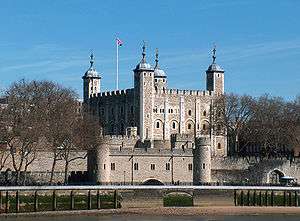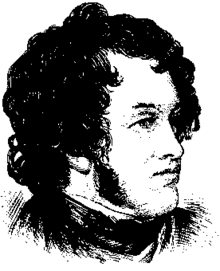Tower of London in popular culture


The Tower of London has been represented in popular culture in many ways. As a result of 16th and 19th century writers, the Tower has a reputation as a grim fortress, a place of torture and execution.[1]
One of the earliest traditions associated with the Tower was that it was built by Julius Caesar; the story was a popular amongst writers and antiquaries. The earliest recorded attribution of the Tower to the Roman ruler dates to the mid-14th century in a poem by Sir Thomas Gray.[2] The origin of the myth is uncertain, although it may be related to the fact that the Tower was built in the corner of London's Roman walls. Another possibility is that someone misread a passage from Gervase of Tilbury in which he says Caesar built a tower at Odnea in France. Gervase wrote Odnea as Dodres, which is close to the French for London, Londres.[3] Today, the story survives in William Shakespeare's Richard II and Richard III,[4] and as late as the 18th century some still regarded the Tower as built by Caesar.[5]
- The Tower of London (1840) by William Harrison Ainsworth though written in fictional form, contrives to give a detailed account of the history and architecture of the Tower. He however included extensive underground passages and dungeons which did not actually exist.
- The Tower of London, as a place of death, treachery and sorrow, is most famously evoked in William Shakespeare's play, Richard III, where it forms the backdrop of Richard's seizure of the throne and the scene of the notorious murder of the Princes in the Tower, and other victims (see above). A classic film version of this is Richard III (1955) with Laurence Olivier in the title role. This story is also reprised in the historical horror film Tower of London (1939) and its 1962 remake.
- Gilbert and Sullivan's 1888 comic opera The Yeomen of the Guard, set at the Tower,[6] has familiarised people throughout the English-speaking world with the Tower for over a century. This is the only Gilbert and Sullivan opera involving an actual historical person, Sir Richard Cholmondeley, Lieutenant of the Tower.[7]
- Apparitions of Anne Boleyn at the Tower are the theme of the song "With Her Head Tucked Underneath Her Arm".
- The Mad Hatter Mystery, a detective novel by John Dickson Carr, where the Tower serves as scene of a murder (Harper & Row Inc., New York, 1933, 1961).
- A Night in Terror Tower, the twenty-sixth book in the Goosebumps series by R. L. Stine (Scholastic, January 1995). Also adapted into a two-part episode, an audiobook, and a board game.
- There was an adventure computer game called Traitors Gate released by Swedish Daydream Software in 1999. In the game, the player is an American agent who must secretly steal the crown jewels in 12 hours. The game took place in a CGI recreation of the whole Tower area.
- The Tower of London features frequently, and is described in exhaustive detail, in Neal Stephenson's Baroque Cycle, especially The System of the World, in which the tower is the setting for one of the series' grandest set pieces.
- The Tower of London has featured multiple times in the long-running BBC television science fiction series Doctor Who:
- in the 2005 Christmas special "The Christmas Invasion", it was the secret headquarters of the fictional military organization UNIT. The UNIT base also reappeared in the 2012 episode The Power of Three.
- in the 2010 episode "The Beast Below" it was shown to be present on "Starship UK", a massive spaceship containing the population of Britain in the 29th century.
- the Tower plays a key role in the show's 50th anniversary special, The Day of the Doctor:
- in 1562, the Tenth Doctor, Eleventh Doctor and War Doctor are imprisoned in the Tower by Queen Elizabeth I while she is impersonating the commander of a group of shape-shifting alien invaders called Zygons.
- by 2013, the Tower houses UNIT's Black Archives, a storehouse of dangerous extraterrestrial or time displaced technology, where the Doctors and UNIT personnel confront the Zygons and conclude a treaty.
- in an early scene, the head of UNIT remarks that the Tower's ravens are "looking a little sluggish" and "need new batteries."
- The Tower of London is seen many times in the Roland Emmerich's 2011 movie Anonymous.
- The Tower is the setting for the final battle in the anime version of Hellsing, where Alucard faces against Incognito.
- The Tower is the setting for Johnny English when the crown jewels are stolen by Pascal Sauvage.
- In the novel Sent, by Margaret Peterson Haddix, Jonah and Katherine try to save their friends Chip and Alex from the Tower of London.
- The Tower of London is often portrayed in the Bartimaeus Trilogy, by Jonathan Stroud, as a prison.
- In the novel Stars and Stripes Triumphant, the Tower of London is partially destroyed by invading American ironclads.
- In the novel Too Many Magicians by Randall Garrett, the character Sean O'Lochlainn is imprisoned in the Tower of London.
- In the game Simcity Societies, one of the prison-like buildings, dungeon, looks-like the Tower of London.
- The Tower of London was featured on 1000 Ways to Die.
- In episode 20 of the anime series Kuroshitsuji, Ciel's butler is tortured in the tower. The princes Edward V and Richard who were held prisoners in the tower also make an appearance as ghosts in episode 16.
- In The Adventures of Robin Hood (TV series), Prince John is shown as resident in and holding court in the tower. John's presence in The Tower is established through the use of photographs of the structure.
- "Towers of London" is a song by the British rock band XTC from their 1980 album Black Sea. The song was written by Andy Partridge.
- The novel "Balthazar Jones and the Tower of London Zoo" by Julia Stuart is almost entirely set inside the Tower of London.
- In Charlie Higson's post-apocalyptic young adult horror novel The Enemy (2009), Small Sam escapes being kidnapped, twice, each by cannibalistic adults, and ultimately joins up with a group that takes refuge in the Tower of London.
- Walter Raleigh - Royal favour with Queen Elizabeth had been restored by this time, but his good fortune did not last. The Queen died in 1603, and Raleigh was arrested at Exeter Inn, Ashburton, Devon, and imprisoned in the Tower of London on 19 July 1603. On 17 November, Raleigh was tried in the converted Great Hall of Winchester Castle for treason, due to his involvement in the Main Plot against King James.
- The Tower features in the early scenes of the BBC Sherlock episode "The Reichenbach Falls" as Jim Moriarty is seen entering and stealing the Crown Jewels - only to be (deliberately) caught wearing them there.
- In My Fair Madeline, with the lead character based on the Madeline books,Madeline's accidental misbehavior at the Louvre while trying to catch two thieves who planned to steal the Mona Lisa took her to a finishing school in London. When she and her classmates took a trip to the Tower of London,she witnessed the two thieves trying to steal the Crown Jewels. After she and one of her classmates,Emma,won a trip to the Tower for being the best behaved girl,the two girls,along with Madeline's friends from Paris,witnessed the theft of the Crown Jewels and Madeline ended up getting knighted by the King for saving the Crown Jewels.
- In Minions, Scarlet Overkill sent Kelvin, Bob and Stuart to steal the Crown Jewels from the Tower of London so that she could become the new Queen of the UK. However,the Crown was taken out of its glass case as Queen Elizabeth II was going round London in a carriage,so the three minions attempted to rob the Crown from the Queen by getting on her carriage.
- The Tower appears in the A Certain Magical Index series of light novels. Although it is a tourist attraction in the setting, it is still secretly used to house prisoners. A few antagonistic characters from the magic side would later end up in the Tower.
References
- Notes
- ↑ Impey & Parnell 2000, p. 91
- ↑ Nearing 1948, p. 229
- ↑ Nearing 1948, pp. 231–232
- ↑ Nearing 1948, p. 228
- ↑ Nearing 1948, p. 233
- ↑ Fischler 1996, p. 203
- ↑ Bradley 1996, p. 772
- Bibliography
- Bradley, Ian (1996), The Complete Annotated Gilbert and Sullivan, Oxford, England: Oxford University Press, ISBN 0-19-816503-X
- Fischler, Alan (1996), "From Weydon-Priors to Tower Green: The Sources of the Yeomen of the Guard", ELH, The Johns Hopkins University Press, 63 (1): 203–225, doi:10.1353/elh.1996.0003, JSTOR 30030279 (subscription required)
- Impey, Edward; Parnell, Geoffrey (2000), The Tower of London: The Official Illustrated History, Merrell Publishers in association with Historic Royal Palaces, ISBN 1-85894-106-7
- Nearing, Homer Jr. (April 1948), "Julius Caesar and the Tower of London", Modern Language Notes, Johns Hopkins University Press, 63 (4): 228–233, JSTOR 2908562